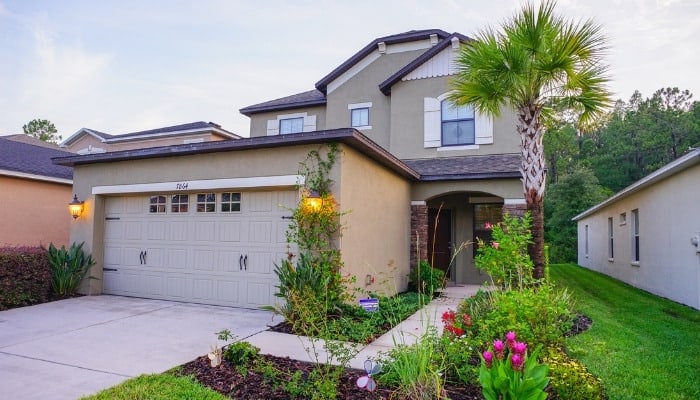The selection of plants for your front yard can significantly alter the look of your yard and the appearance of your house.
If you’re considering using one or more palm trees in your landscaping project, it can be challenging to know which ones will look the best or be the best suited to your specific needs.
Fortunately, we’ve performed extensive research and compiled this list of 15 gorgeous, low-maintenance palm trees that you should consider planting in your front yard.
1. Pindo Palm

Pindo palms, commonly called jelly palms, are beautiful bright-green palm trees that grow bushels of bright, edible berries that people sometimes use to make jams and jelly (hence the name).
Native to South America, these trees can grow up to 20 feet tall with a canopy roughly 15 feet wide once they reach maturity.
They thrive in bright sun and are commonly found in the states like California and Florida but can withstand cooler temperatures than some other species of palm trees.
- Botanical Name: Butia capitata
- Average Size: 15 to 20 feet
- Key Features: Green, spikey fronds and bright orange berries
- Growth Rate: Slow
- Light Requirements: Prefer full sun, may withstand partial shade
2. Areca Palm

The areca palm, also commonly referred to as a butterfly palm or bamboo palm, grows in a collection of thin, golden fronds with bushy green growth resembling bamboo.
Native to Madagascar, these palms prefer bright, filtered sunlight when planted outdoors to avoid being sunburnt but can sometimes withstand full sunlight, as well.
These palms are commonly grown as houseplants, which will grow slightly less bushy and tall than if planted outdoors, but they are known to improve indoor air quality.
Although relatively low in maintenance, these palms prefer slightly more acidic soil pH and tend to be sensitive to fluoride, so use care if you live in an area with treated water.
- Botanical Name: Dypsis lutescens
- Average Size: Up to 30 feet
- Key Features: Bushy, bamboo-like growth pattern
- Growth Rate: Slow
- Light Requirements: Bright, filtered sunlight
3. Pygmy Date Palm
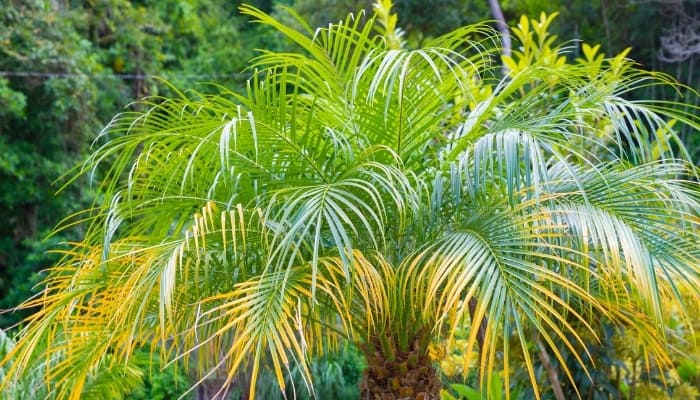
Pygmy date palms are an excellent option if you’re looking for beautiful green foliage at a slightly lower height than many other palm species.
Only growing to about 10 feet tall, these petite palm trees grow with a single trunk, but unlike many other palms, they can be planted close together in clumps of several trees.
The female trees produce bunches of dark-colored edible drupes and can be grown both outdoors and indoors.
- Botanical Name: Phoenix roebelenii
- Average Size: Up to 10 feet
- Key Features: Female trees grow edible, purple fruit
- Growth Rate: Slow
- Light Requirements: Medium to full sun
4. Foxtail Palm

Native to Australia, these relatively fast-growing palms are characterized by their gray, smooth trunks and collection of eight to 10 bright, bushy fronds resembling foxtails that collect at the top.
Thriving in tropical areas, this palm loves full sunlight and is fairly drought tolerant, although it will flourish with regular watering.
- Botanical Name: Wodyetia bifurcata
- Average Size: 20-30 feet
- Key Features: Bushy green fronds
- Growth Rate: Moderate to quick
- Light Requirements: Full sun
5. Canary Island Date Palm
As the name implies, the Canary Island date palm is originally from the Canary Islands off the coast of Africa and does best when it has plenty of sunlight and room to grow.
Featuring long, rigid fronds that can grow up to 50 feet wide and a diamond-patterned trunk from old leaf growth, this beautiful palm can make a statement in your yard, although it may take a while to reach its full potential.
- Botanical Name: Phoenix canariensis
- Average Size: 40-60 feet
- Key Features: Diamond-patterned trunk
- Growth Rate: Slow
- Light Requirements: Full sun
6. Queen Palm

Queen palms are tall, gorgeous palm trees that are often planted coastally because of their moderate tolerance of sea spray and large feather fronds.
These palms are slightly more maintenance than some other varieties as they are not considered “self-cleaning,” which means you will have to remove dead leaves manually.
Furthermore, queen palm’s fruit can grow in bunches weighing more than 100 pounds, so you will need to stay on top of dropping fruit to prevent rotting.
- Botanical Name: Syagrus romanzoffiana
- Average Size: Up to 50 feet
- Key Features: In ideal conditions, queen palms flower in the summer and fruit by winter
- Growth Rate: Moderate to quick
- Light Requirements: Full sun
7. Cat Palm
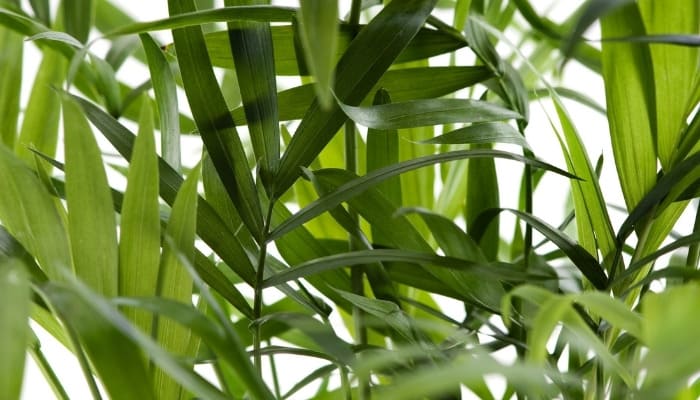
Cat palms, also called cascade palms, are a small palm variety that can grow indoors or outdoors. Inside, they grow best with bright, indirect light while preferring partial shade when grown outdoors.
They are characterized by their small, bushy appearance featuring shiny green fronds that grow without a trunk and look similar to the areca palm.
- Botanical Name: Chamaedorea cataractarum
- Average Size: 6-8 feet
- Key Features: Short, bushy palm fronds with no trunk
- Growth Rate: Slow
- Light Requirements: Partial shade
8. Fishtail Palm
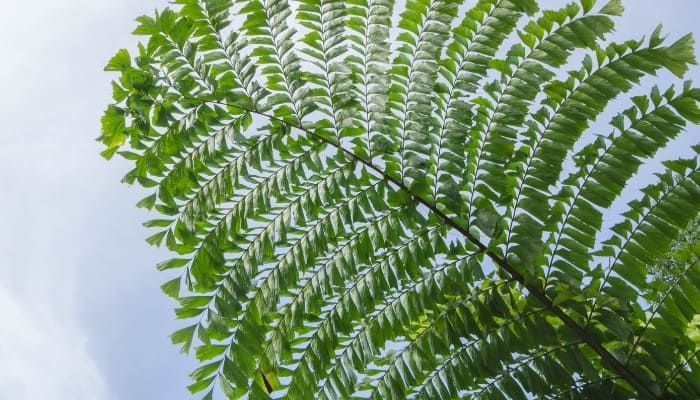
Fishtail palms are very distinct, featuring flat, broad leaves resembling fishtails. The palm can reach up to 25 feet, and the fronds grow very densely, providing privacy similar to bamboo.
These palms possess bunches of reddish berries, but unlike the queen palm, the fruit doesn’t require the chore of consistently cleaning up fallen berries.
- Botanical Name: Caryota mitis
- Average Size: 15-25 feet
- Key Features: Flat, broad leaves
- Growth Rate: Slow
- Light Requirements: Full sun to partial shade
9. Mediterranean Fan Palm

As the name implies, the Mediterranean fan palm, also called the European fan palm, is native to the Mediterranean and features multiple thick, textured trunks with rigid, fan-shaped fronds on top.
These palms are relatively low-maintenance plants. While preferring bright, direct light, they are moderately drought resistant and grow in various soil conditions.
- Botanical Name: Chamaerops humilis
- Average Size: Up to 15 feet
- Key Features: Fan-shaped fronds
- Growth Rate: Slow
- Light Requirements: Full sun to partial shade
10. Lady Palm
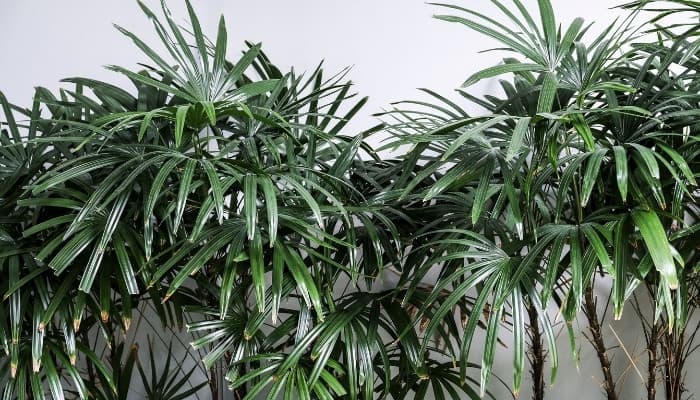
The lady palm grows well indoors because of its tolerance to low-light conditions compared to other palm varieties.
In fact, when grown in partial shade, the lady palm will maintain its optimum dark, green coloring.
In addition, they are more tolerant to cooler conditions, making them a good option for slightly less temperate areas.
- Botanical Name: Rhapis excelsa
- Average Size: Up to 15 feet
- Key Features: Dense growth patterns with thin stems and fan-shaped fronds
- Growth Rate: Slow
- Light Requirements: Partial shade
11. Sylvester Palm

Native to India, the Sylvester palm, also known as the Sylvester date palm, is a moderately sized palm that features an attractive, textured trunk and feathered, sprawling fronds.
This palm is a low-maintenance option for homeowners looking for a slightly more drought-resistant, salt-resistant palm that can tolerate relatively cool winter temperatures.
- Botanical Name: Phoenix sylvestris
- Average Size: 40-60 feet
- Key Features: Pineapple-like trunk, colored berries
- Growth Rate: Moderate
- Light Requirements: Full sun
12. Christmas Palm

The Christmas palm is a gorgeous palm native to the Philippines and named for the clusters of shiny, bright red drupes it grows in the late fall and wintertime.
This moderately-sized palm proliferates in its youth and then slows down significantly once it surpasses roughly 6 feet in height.
- Botanical Name: Adonidia merrillii
- Average Size: 15-25 feet
- Key Features: Bunches of bright red drupes
- Growth Rate: Quick at first, slows after it reaches about 6 feet
- Light Requirements: Full sun
13. Chinese Fan Palm

The Chinese fan palm features fan-shaped fronds that are stiff when young and eventually droop as they get older, which is why this palm is also sometimes referred to as a fountain palm.
These low-maintenance palms can withstand temperatures as low as 20°F (-6.67°C) and are relatively drought and salt-tolerant once mature.
- Botanical Name: Livistona chinensis
- Average Size: 30-50 feet
- Key Features: Fan-shaped fronds
- Growth Rate: Slow
- Light Requirements: Full to partial sun
14. Mexican Blue Palm
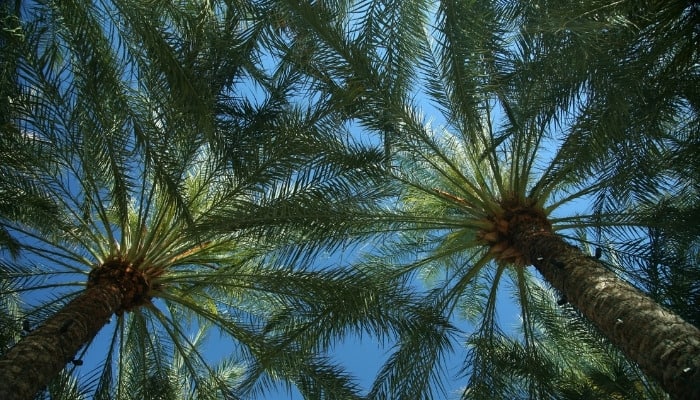
Native to Mexico, these gorgeous palms feature striking silvery blue fronds, thrive in warm and arid conditions, and grow better in areas with lower humidity levels.
They are often seen growing farther north than many other palm varieties, as they are relatively cold tolerant.
- Botanical Name: Brahea armata
- Average Size: 20-50 feet
- Key Features: Attractive blue/silver coloring
- Growth Rate: Slow
- Light Requirements: Full sun
15. Red Latan Palm

Red latan palms are an attractive option for landscaping as they feature striking coloration that adjusts as the plant matures.
When still young, the red latan palm features all-red leaves that eventually turn green as the palm gets older. However, the frond stems and the leaf tips hold on to their reddish color, even on mature palms.
- Botanical Name: Latania lontaroides
- Average Size: 30-40 feet
- Key Features: Red leaves and stems with brown/green fruit
- Growth Rate: Slow
- Light Requirements: Full sun to partial shade
Final Thoughts
These 15 palm trees all offer different features and have different growing needs, which means there is sure to be a palm on this list for everybody.
If you’re considering planting one or more palm trees in your front yard, consider one of the above palm trees and check their specific requirements to ensure they will thrive in your yard.

